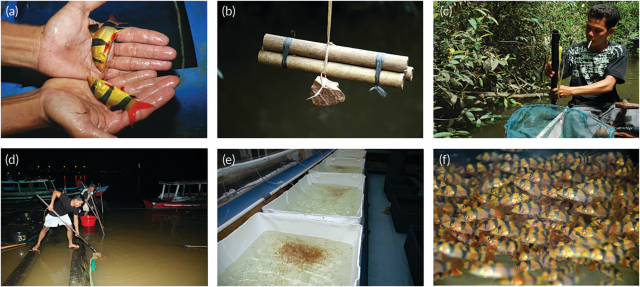From a paper published in Feb 2019.
CASE STUDY 3: OVERFISHING CLOWN LOACH CHROMOBOTIA MICRACANTHUS AND ALTERNATIVES

onlinelibrary.wiley.com
The clown loach
C. macracanthus or tiger botia, is a well‐known tropical
freshwater fish belonging to the Botiidae family. It originates from inland waters of Indonesia, on the islands of Sumatra and Borneo. It is a popular and familiar fish in the aquarium trade and is sold worldwide (Dudgeon,
2000). Traditionally, the most common collection technique involved using lengths of bamboo with openings cut into each segment (see Figure
4). These are normally weighted with stones to make them sink and hung from overhanging or
marginal vegetation. The loaches take refuge in these at night and the fishermen return during the hours of darkness to collect them. Smaller specimens of 20–80 mm have been collected in this way for many decades, usually during January–March but numbers have fallen away sharply since the turn of the century. To satisfy demand in the ornamental fish industry, the out‐take in 1997 was 20 million juveniles (Ng & Tan,
1997). In 2009, that number had increased to 50 million (Legendre
et al.,
2012). Industry specialists note a persistent decrease in the number of juvenile fish caught using this method, albeit fished with increasing intensity for almost 30 years (Dudgeon,
2000). It became evidently clear that this species was overexploited and threatened and this prompted the Indonesian government in 2002 to forbid the export of fish > 15 cm, which are considered sexually mature. Given that annual catches of smaller fish have declined greatly,
native fishermen in some areas have been forced to change their tactics in order to continue trading.
Figure 4

The ornamental fishery for clown loach in Sumatra: (a)
Chromobotia macracanthus; (b)–(c) traditional capture method for using lengths of bamboo weighted with stones, and hung from overhanging vegetation, in which
C. macracanthus take refuge at night, when (c) the fishermen return during the hours of darkness to collect them. (d) Fishermen from the Batang Hari
river capturing
C. macracanthus larvae at night for (e)–(f) on‐growing in simple aquaculture facilities
In nature, this species is a migratory spawner, moving from the main
river channels into smaller tributaries and temporarily inundated flood plains during the rainy season. These movements usually begin in September with
spawning typically occurring in late September–early October, though the timing of this is beginning to shift with the changing climate (Evers,
2009a). The eggs drift and come to settle in the
riparian vegetation where the initially
pelagic larvae spend their early days feeding on micro‐organisms. Some drift too far, enter the main rivers and are swept downstream and out to sea and hence are lost. However,
native fishermen in the Batang Hari
river system in Sumatra have come to take advantage of this phenomenon (Evers,
2009b). Local fishermen now collect the
pelagic larvae that drift into the main
river channel and grow them on to sell to middlemen or larger distributors (Figure
4). Perhaps as many as 10 million specimens are raised and shipped from the area in this way each year.
At one time all traded fish were wild‐collected, mostly from Sumatra, but these days the situation is less clear. While many thousands of wild specimens are still caught and sold annually, farmers in South‐east Asia have been artificially breeding the
species with the use of hormones for several years (Legendre
et al.,
2012; Ng & Tan
1997). Hormones are used to stimulate oocyte maturation and ovulation (Legendre
et al.,
2012). More recently breeders from the Czech Republic, Russia and other parts of Eastern Europe have perfected a similar technique, which has seen the price of the once‐expensive captive‐bred fish drop considerably.




